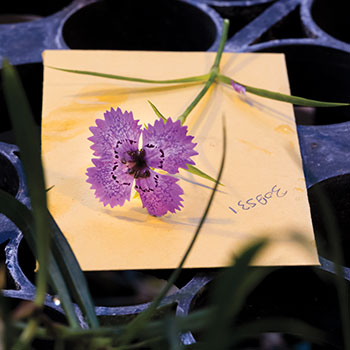Why is the Y chromosome slowly disappearing in human DNA?
It’s a question that has baffled scientists since they began understanding DNA, and it’s one that Michael E. Hood, associate professor of biology, believes he can help answer—using a fungus that infects a carnation-like flower.
The problem lies in the unusual nature of the human male sex chromosomes, the only two in human DNA that are unequally matched, with an X and Y pairing up to create a male. In all other chromosomes, humans typically have two copies, but that’s not true for the Y, which is always paired with an X.
This combination means that changes to the Y are sheltered by its X counterpart; they never appear either as expressed mutations or get corrected, as similar changes would in other parts of the DNA sequence. It’s the evolutionary equivalent of a stalagmite in a cave, slowly building up defects one tiny change at a time.
“There seem to be certain places in the genome where harmful mutations accumulate,” Hood says. “The X can’t degenerate in that way because, in females, that’s all you’ve got.”
While no one is really worried about men going extinct (as the tabloid interpretation would have readers believe), scientists are interested in understanding the gradual process of genetic deterioration and where it might eventually lead. It’s a difficult question to explore, since the answer involves tracking human DNA and the harmful mutations genomes accumulate over many generations.

There is no such thing as a male or female anther smut, but the fungi do have two mating types with a pair of chromosomes (remarkably similar to XY) that are undergoing degeneration in the same way.
There are other advantages to anther smut: the fungal models are safe for researchers to use, the fungus is easy to grow, and, unlike humans, fungi have small genomes that make the sequencing process simple. Hood can grow a generation in a few weeks and also has access to a large group of related species.
This is not the first time Hood has used anther smut to test theoretical problems. In the fall, he received a $1.7 million grant, together with colleagues at other schools, to use the fungus in the study of sexually transmitted diseases.
“Computer simulations, theoretical work, are really good at indicating what might happen in nature, but that’s quite different from saying what does happen in nature,” Hood says. “The empirical evidence, with a real biological system, finishes off that investigation in a way.”
By tackling fundamental questions—does the degeneration of the Y chromosome slow over time, for example, or does it simply continue until the chromosome is gone?—Hood hopes his work will help clear the way toward solving basic problems that humans face at the genetic level and in disease.
“One of the things I like most about biology is that there’s an answer in there somewhere, and it takes real investigation in order to pull out the explanation,” Hood says. “It’s fun to do the work to try to resolve a mystery.”
